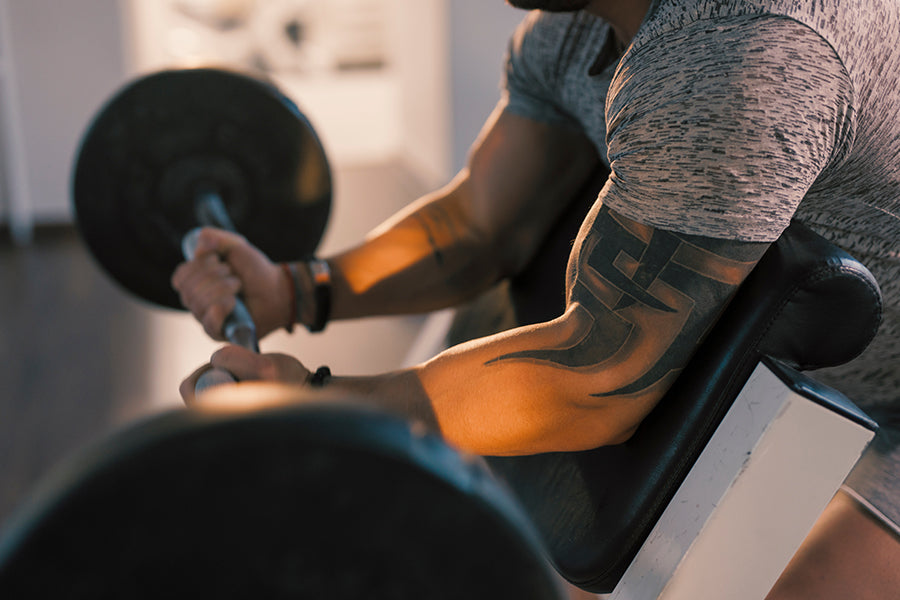So, you want to build some seriously impressive biceps, eh? Well, you're in luck. Preacher curls are one of the best exercises for achieving that goal. Preacher curls are named after the position in which you perform them — seated at a preacher bench with your arms extended and your palms facing upward.
The incline of the bench allows you to keep good form while performing the exercise and provides a greater range of motion than doing curls standing up. There are different variations of exercise that you can incorporate easily into your workout routine.
Let’s dive into the topic in detail and see what preacher curls are, how to do them correctly, their benefits, and much more!
What are Preacher Curls?
A preacher curl is a popular biceps curl variation, an exercise used to strengthen the muscles of the upper arms. The preacher curl gets its name from the position of the arms when performing the exercise: they are rested against a slanted bench, often with a towel draped over them, in a position that resembles that of a preacher giving a sermon.
This position allows for a greater range of motion than a traditional biceps curl, making the exercise more effective. Preacher curls can be performed with dumbbells,barbells, kettlebells, or resistance bands.
Preacher Curls Muscles Worked
The preacher curl primarily targets the biceps brachii, also known as the biceps, as a single muscle group. There are two "heads" to these substantial muscles on the front of the upper arms. According to the University of Arkansas for Medical Sciences, they have two attachment points: the short head arises at the coracoid process of the scapula, whereas the long one originates at the supraglenoid tubercle of the scapula.
The biceps is regarded as the archetypal flexing muscles, and having large biceps has come to represent strength and toughness. However, even those who don't want to be bodybuilders or bodyguards might benefit from having strong biceps. They are the muscles that allow you to lift a large bag of groceries or a bucket of water because they are in charge of flexing the arm at the elbow and sustaining tension against resistance when the arm is in a flexed posture.
They also help with other exercises and help you make these other moves better by strengthening your biceps.
Related Article: 10 Biceps Curl Variations for Big Arms and Healthy Shoulders
Benefits of the Preacher Curl
The preacher curl is one of the most popular exercises for developing more prominent, stronger biceps. And for a good reason – it’s a practical exercise that can be done with various equipment. But what are the benefits of this exercise? Let’s take a closer look.
Stronger Biceps
Your biceps work harder to complete the curl movement when sitting down than when you're doing most other bicep curls variations since your upper body and arms are immobile. You can only trick yourself in this exercise by not extending your elbows or rocking back and forth as you curl the bar. Consequently, it's much simpler to concentrate solely on the weight and the burn.
Your biceps can grow better the more high-quality biceps isolation workout you can complete. Slow the preacher curl down to boost your forearms, especially during the eccentric (lowering) phase.
Contribute to Compound Exercises
Even though they are not the primary movers, your biceps are nonetheless involved in exercises like rows, chin-ups, and pull-ups. They are also the unsung heroes of moves that target your shoulders, upper back, and lats.
Isn't it unfortunate that your biceps give out before your back and shoulders fully engage? Having bigger biceps will only help develop a strong and muscular back since you are only as strong as your weakest link.
More Stable Shoulders
The double-headed biceps muscle joins to both the scapula and the shoulder joint. Through your anterior deltoid, specifically, your biceps play a job in assisting your rotator cuff with shoulder stability.
Think of your rotator cuff as the anchor that holds your humerus to your shoulder joint. Your biceps hold your humerus and shoulder joint together. This compression benefits your shoulder stability from both sides. Preacher curls, a biceps exercise, can assist increase this stability.
Related Article: How to Strengthen Your Shoulders and Get the Muscles You Want
How to Do Preacher Curls With Perfect Form

Although the preacher curl is not a strenuous exercise, mistakes can be made if proper form is not used. When holding a big weight in a barbell preacher curl, the position of the upper arms on the pads makes it simple to allow the arms to hyperextend at the elbows, which can be problematic for the elbow. Here's what you must do instead:
- Sit down at the machine after adjusting the seat height. When performing a preacher curl with a barbell, you must either sit down while holding the weight in your hands or have someone hand it to you after you have taken a seat. Use the pin in the weight stack to change the resistance if you're using a machine.
- Put the pads under your upper arms. Whenever you are using a machine, hold onto the handles. Your hands should be about shoulders' width apart if you are holding a bar.
- To prevent hyperextension, maintain tension in your biceps and a tiny bend in your elbow.
- Keep your spine straight by engaging your core muscles.
- Curl the bar slowly in the direction of your shoulders.
- At the top, contract your biceps, then gradually lower the bar.
- To prevent hyperextension, maintain tension in your biceps at the bottom of the exercise before beginning your next repetition.
According to the American Council on Exercise, swinging your body backward can also strain your lower back. Maintain a tight core and a secure position for your torso throughout the movement.
Preacher Curl Variations
The preacher curl is a fantastic exercise for targeting the biceps but can quickly become stale if you don't mix things up. Here are different variations on the standard preacher curl that will keep your muscles guessing and help you to achieve new gains.
Close-Grip Preacher Curls

You'll set up for this variation the same way you would for the standard preacher curl. Nevertheless, you'll use a narrow grip this time. You can accentuate either of your biceps muscles' two heads by varying the width of your grip. Your biceps muscles have two heads: the long and the short.
While a smaller grip will highlight the long head, a wide grasp will highlight the short head. Utilize different grip techniques to encourage the development of more complete muscles.
Dumbbell Preacher Curls

You have a few more alternatives with dumbbell preacher curls than with barbell ones. To accentuate asymmetries between the sides, you can train alone. Using a dumbbell, you can avoid accidentally having your dominant arm take over the exercise. That will enable you to guarantee more even muscle development.
You have more mobility with dumbbells since you can change your grip to be overhand, underhand, or neutral. In terms of your forearms and the two heads of your biceps, doing this provides you even more control over the muscles you're isolating.
Kettlebell Preacher Curl

Using a kettlebell as resistance for the preacher curl is an intriguing variation. A kettlebell would need to be held in each hand, and both arms would need to be above an inclined bench. Maintain a neutral spine and let the bench rest beneath your armpit.
The kettlebells should then be steadily raised to shoulder height. For the preset number of sets and repetitions, repeat this method. This version is more challenging than the typical preacher curl performed with a dumbbell or barbell because the kettlebell's weight is distributed more centrally, requiring more stability and offering a different training stimulus.
FAQs
1. Does the preacher curl work the inner or outer bicep?
The biceps' short head carries the most weight during the preacher curl. As a result, the preacher curl is better for strengthening the inner biceps than the biceps exterior muscle.
2. Do preacher curls make your arms bigger?
The preacher curls could make your arms bigger because they work the biceps muscles in your arms and can lead to muscle growth over time. However, whether or not preacher curls will make your arms bigger depends on several factors, such as genetics and diet.
If you want to increase the size of your arms, preacher curls may be an excellent exercise. Still, it is always best to consult a fitness professional to get tailored advice.
3. How long does it take to see growth in the biceps?
There is no set answer, as everyone's body will respond differently. However, typically speaking, noticeable growth in the biceps can take anywhere from 6-8 weeks.
4. What exercise builds biceps the fastest?
There is no definitive answer as to which exercise builds biceps the fastest. However, some exercises that may help build biceps include curl exercises, hammer curls, and preacher curls.
The Bottom Line
The preacher curl is an excellent exercise for targeting your biceps. Proper form is essential to get the most out of the exercise and avoid injuries. You can keep your workouts interesting with a few variations of the preacher curl, including close-grip, dumbbell, and kettlebell preacher curl.
There are numerous benefits that this exercise provides, like shoulder stability, more muscular biceps, and assistance in different compound exercises. Be sure to mix up your routine and try different exercises to target all your arms' muscles for complete development.











